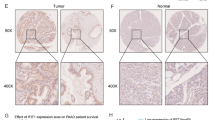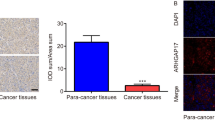Abstract
Pancreatic cancer is a common malignancy with a bleak outcome due to the early occurrence of micro-metastases and poor prognosis. The epithelial-mesenchymal transition (EMT) is considered to be related to the invasion and metastasis of a variety of malignant tumors. Currently, there is no research regarding the relationship of pancreatic cancer EMT with Jun dimerization protein 2 (JDP2), an inhibitor of the activator protein-1 (AP-1) family, and activating transcription factor-2 (ATF2), an AP-1-family member. In this study, we used western blot analysis and immunofluorescence to detect the protein expression of the epithelial marker E-cadherin and the mesenchymal marker vimentin in the pancreatic cancer cell line BxPC3, which was transfected with JDP2 and induced by Collagen I. Compared with the negative control, the E-cadherin and vimentin expression levels did not change significantly, whereas E-cadherin expression decreased and vimentin expression increased in the control group transfected with empty plasmid, suggesting that JDP2 inhibits the EMT induced by Collagen I. Additionally, we verified that compared with the negative control, the morphology of the Capan2 cell line induced by TGF-β1 after transfection with ATF2 was significantly changed, as was the mRNA expression of E-cadherin, whereas the mRNA expression of vimentin, Snail, and ATF2 was significantly increased. Cell invasiveness was also significantly increased (P < 0.01), suggesting that ATF2, together with TGF-β1, induced EMT in the Capan2 cell line. The members of the AP-1 family are closely related to EMT and that JDP2, as an AP-1-family inhibitor, inhibits EMT, which could lead to a new direction in molecular-targeted therapy for pancreatic cancer.




Similar content being viewed by others
References
Jemal A, Siegel R, Ward E, Murray T, Xu J, Smigal C, Thun MJ, Cancer statistics (2006) CA Cancer J Clin 56:106–30
Aronheim A, Zandi E, Hennemann H, Elledge SJ, Karin M (1997) Isolation of an AP-1 repressor by a novel method for detecting protein-protein interactions. Mol Cell Biol 17:3094–102
Heinrich R, Livne E, Ben-Izhak O, Aronheim A (2004) The c-Jun dimerization protein 2 inhibits cell transformation and acts as a tumor suppressor gene. J Biol Chem 279:5708–15
Landschulz WH, Johnson PF, McKnight SL (1988) The leucine zipper: a hypothetical structure common to a new class of DNA binding proteins. Science 240:1759–64
Glover JN, Harrison SC (1995) Crystal structure of the heterodimeric bZIP transcription factor c-Fos-c-Jun bound to DNA. Nature 373:257–61
Bakin AV, Rinehart C, Tomlinson AK, Arteaga CL (2002) p38 mitogen-activated protein kinase is required for TGFbeta-mediated fibroblastic transdifferentiation and cell migration. J Cell Sci 115:3193–206
Cheng GZ, Chan J, Wang Q, Zhang W, Sun CD, Wang LH (2007) Twist transcriptionally up-regulates AKT2 in breast cancer cells leading to increased migration, invasion, and resistance to paclitaxel. Cancer Res 67:1979–87
Huang TC, Kar S, Javle M (2010) Personalized therapy for pancreatic cancer: Myth or reality in 2010? J Gastrointest Oncol 1:24–33
Kotowski A, Ma WW (2011) Emerging therapies in pancreas cancer. J Gastrointest Oncol 2:93–103
Xiao DK, He JX (2010) Epithelial mesenchymal transition and lung cancer. J Thorac Dis 2:154–9
Shintani Y, Hollingsworth MA, Wheelock MJ, Johnson KR (2006) Collagen I promotes metastasis in pancreatic cancer by activating c-Jun NH(2)-terminal kinase 1 and up-regulating N-cadherin expression. Cancer Res 66:11745–53
Thuault S, Valcourt U, Petersen M, Manfioletti G, Heldin CH, Moustakas A (2006) Transforming growth factor-beta employs HMGA2 to elicit epithelial-mesenchymal transition. J Cell Biol 174:175–83
Thuault S, Tan EJ, Peinado H, Cano A, Heldin CH, Moustakas A (2008) HMGA2 and Smads co-regulate SNAIL1 expression during induction of epithelial-to-mesenchymal transition. J Biol Chem 283:33437–46
Davies M, Robinson M, Smith E, Huntley S, Prime S, Paterson I (2005) Induction of an epithelial to mesenchymal transition in human immortal and malignant keratinocytes by TGF-beta1 involves MAPK, Smad and AP-1 signalling pathways. J Cell Biochem 95:918–31
Nishioka R, Itoh S, Gui T, Gai Z, Oikawa K, Kawai M, Tani M, Yamaue H, Muragaki Y (2010) SNAIL induces epithelial-to-mesenchymal transition in a human pancreatic cancer cell line (BxPC3) and promotes distant metastasis and invasiveness in vivo. Exp Mol Pathol 89:149–57
Torrisani J, Bournet B, Cordelier P (2008) Buscail L [New molecular targets in pancreatic cancer].[Article in French]. Bull Cancer 95:503–12
Mackenzie RP, McCollum AD (2009) Novel agents for the treatment of adenocarcinoma of the pancreas. Expert Rev Anticancer Ther 9:1473–85
Furukawa T (2009) Molecular pathology of pancreatic cancer: implications for molecular targeting therapy. Clin Gastroenterol Hepatol 7:S35–9
Jin C, Ugai H, Song J, Murata T, Nili F, Sun K, Horikoshi M, Yokoyama KK (2001) Identification of mouse Jun dimerization protein 2 as a novel repressor of ATF-2. FEBS Lett 489:34–41
Jin C, Li H, Murata T, Sun K, Horikoshi M, Chiu R, Yokoyama KK (2002) JDP2, a repressor of AP-1, recruits a histone deacetylase 3 complex to inhibit the retinoic acid-induced differentiation of F9 cells. Mol Cell Biol 22:4815–26
Jin C, Kato K, Chimura T, Yamasaki T, Nakade K, Murata T, Li H, Pan J, Zhao M, Sun K, Chiu R, Ito T, Nagata K, Horikoshi M, Yokoyama KK (2006) Regulation of histone acetylation and nucleosome assembly by transcription factor JDP2. Nat Struct Mol Biol 13:331–8
Yuanhong X, Feng X, Qingchang L, Jianpeng F, Zhe L, Kejian G (2010) Downregulation of AP-1 repressor JDP2 is associated with tumor metastasis and poor prognosis in patients with pancreatic carcinoma. Int J Biol Markers 25:136–40
Benbrook DM, Jones NC (1990) Heterodimer formation between CREB and JUN proteins. Oncogene 5:295–302
van Dam H, Castellazzi M (2001) Distinct roles of Jun: Fos and Jun: ATF dimers in oncogenesis. Oncogene 20:2453–64
Berger AJ, Kluger HM, Li N, Kielhorn E, Halaban R, Ronai Z, Rimm DL (2003) Subcellular localization of activating transcription factor 2 in melanoma specimens predicts patient survival. Cancer Res 63:8103–7
Papassava P, Gorgoulis VG, Papaevangeliou D, Vlahopoulos S, van Dam H, Zoumpourlis V (2004) Overexpression of activating transcription factor-2 is required for tumor growth and progression in mouse skin tumors. Cancer Res 64:8573–84
Mei Y, Yuan Z, Song B, Li D, Ma C, Hu C, Ching YP, Li M (2008) Activating transcription factor 3 up-regulated by c-Jun NH(2)-terminal kinase/c-Jun contributes to apoptosis induced by potassium deprivation in cerebellar granule neurons. Neuroscience 151:771–9
Lee SH, Bahn JH, Whitlock NC, Baek SJ (2010) Activating transcription factor 2 (ATF2) controls tolfenamic acid-induced ATF3 expression via MAP kinase pathways. Oncogene 29:5182–92
Disclosure
The authors declare no conflicts of interest.
Author information
Authors and Affiliations
Corresponding author
Additional information
Yuanhong Xu and Zhe Liu are contributed equally to this article.
Rights and permissions
About this article
Cite this article
Xu, Y., Liu, Z. & Guo, K. The Effect of JDP2 and ATF2 on the Epithelial-mesenchymal Transition of Human Pancreatic Cancer Cell Lines. Pathol. Oncol. Res. 18, 571–577 (2012). https://doi.org/10.1007/s12253-011-9476-6
Received:
Accepted:
Published:
Issue Date:
DOI: https://doi.org/10.1007/s12253-011-9476-6




